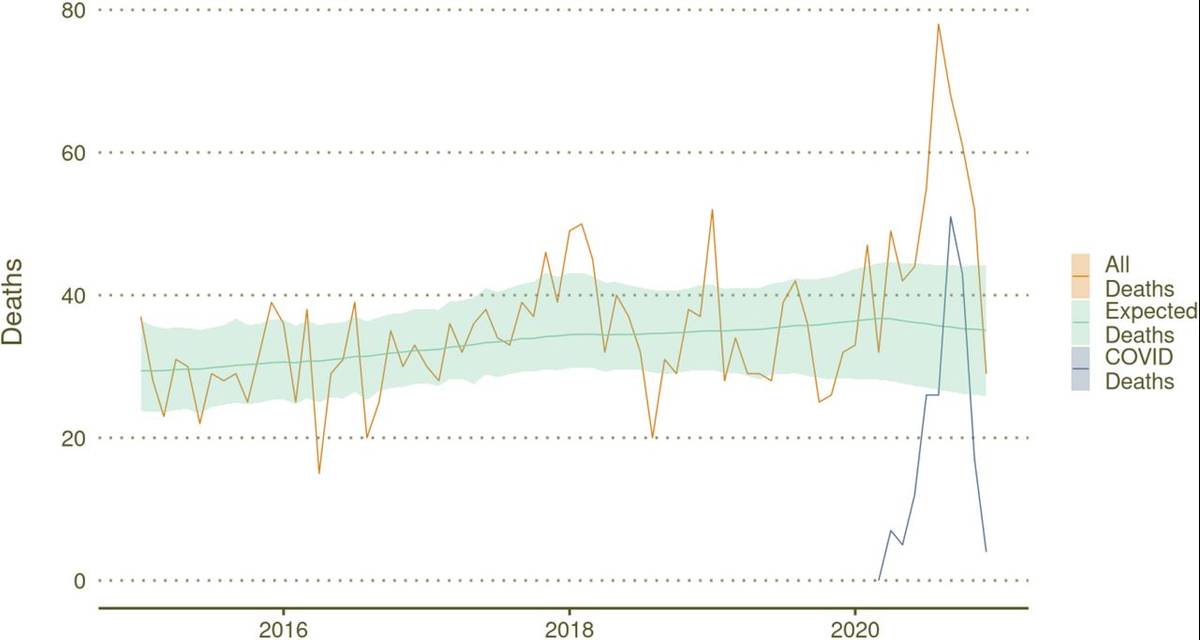April 22nd, 2021 • Joshua Manson
Life Expectancy in Florida Prisons Plummeted During Pandemic, Study Finds

A new study by the UCLA Law COVID-19 Behind Bars Data Project has found that life expectancy among people incarcerated in Florida state prisons has dropped by more than four years, from 77.9 to 73.8 years, during the COVID-19 pandemic — a decline more than four times greater than the recent drop in life expectancy for the U.S. population overall.
The four-year decline, according to the study, is likely caused by the high number of deaths from COVID-19 in the state’s prisons. To date, the Florida Department of Corrections has reported 215 deaths of people in its custody due to COVID-19. Although the agency does not report historical trends or monthly breakdowns of COVID-19 deaths, the study’s authors relied on our project’s data, collected in real time, to count the number of COVID-19 deaths each month.
From March through December 2020, the authors found, there were 42 percent more deaths in the prison system than would be expected based on the mortality rates of previous years. This figure — referred to as the excess mortality rate — was considerably higher for the state’s incarcerated population than for the state’s overall population (15 percent) and the country’s overall population (about 20 percent). Months with high numbers of excess deaths of any cause were accompanied by high numbers of COVID-19 deaths, suggesting that COVID-19 was the primary driver of the excess mortality in Florida prisons over the nine months of the study.
The Centers for Disease Control and Prevention estimated that between January and June 2020, average life expectancy in the United States declined by one year. This decline, itself catastrophic, represents the largest decline in this country since World War II. The fact that the corresponding decline in Florida’s prisons in 2020 was more than four times greater demonstrates what the authors call “the inordinately harmful impact of COVID-19 on the health of Florida’s prison population.”
From the study:
“While prison populations and density have declined in 2020, this study demonstrates that, in Florida at least, these declines have been insufficient to avert catastrophic impacts on mortality rates and life expectancy. Our findings thus offer evidence in support of calls from other experts for vaccine prioritization for the incarcerated and for strategic decarceration. … We urge officials in Florida and other states to evaluate interventions to reduce the risks associated with COVID-19 and to take steps to minimize the observed discrepancies in negative health outcomes between the general public and the incarcerated.”
The authors focused on Florida because that state’s particularly high incarcerated population allowed for a larger sample size. It is also one of the few states that provides historical demographic data for the prison population, allowing for the evaluation of mortality over time.
However, as the study’s authors note, Florida’s prison population demographics (age and sex) are similar to that of other state prison populations, and Florida’s COVID-19 mortality rate is not exceptionally higher than its peer states’. For this reason, it is likely that Florida is not an outlier, and that other state prison systems across the country are experiencing similarly striking drops in life expectancy.
In addition to this study, our data has been used by researchers to show elevated COVID-19 death and infection rates among incarcerated people across the country, as well as among prison staff.
next post
April 26th, 2021 • Joshua Manson
Department of Justice Report Shines Light on the Pandemic in Local Jails
A report released last month by the Department of Justice’s Bureau of Justice Statistics (BJS) contains previously unreleased data showing the spread of COVID-19 in the nation’s jails during the early months of the pandemic. We identified several key takeaways.